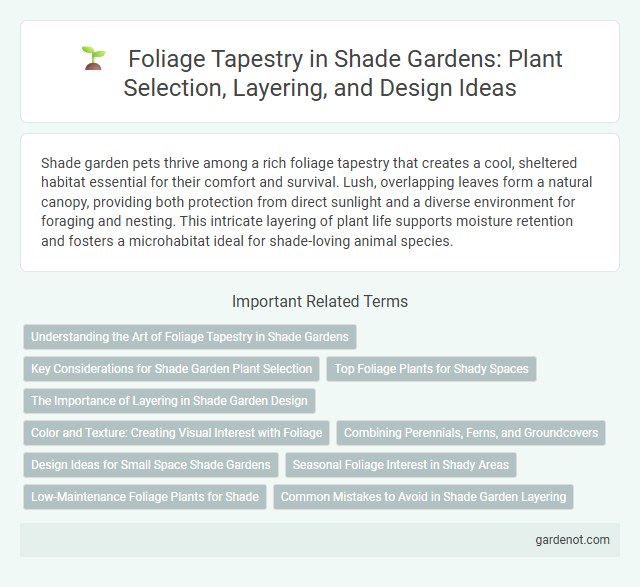Shade garden pets thrive among a rich foliage tapestry that creates a cool, sheltered habitat essential for their comfort and survival. Lush, overlapping leaves form a natural canopy, providing both protection from direct sunlight and a diverse environment for foraging and nesting. This intricate layering of plant life supports moisture retention and fosters a microhabitat ideal for shade-loving animal species.
Understanding the Art of Foliage Tapestry in Shade Gardens
Foliage tapestry in shade gardens involves layering diverse leaf shapes, textures, and colors to create a visually dynamic and lush environment despite limited sunlight. Understanding the selective use of plants like hostas, ferns, and astilbes helps maximize contrast and depth, enhancing the garden's intricate design. Mastering this art transforms shaded areas into vibrant, textured landscapes that thrive under low-light conditions.
Key Considerations for Shade Garden Plant Selection
Selecting plants for a shade garden's foliage tapestry requires emphasis on leaf texture, color variations, and growth habits that thrive in low-light conditions. Key species like hostas, ferns, and astilbes offer diverse leaf shapes and shades of green, silver, and burgundy, creating depth and visual interest under canopy coverage. Soil moisture levels and air circulation are critical factors influencing plant health and vibrant foliage development in shaded landscapes.
Top Foliage Plants for Shady Spaces
Top foliage plants for shady spaces include hostas, ferns, and caladiums, which thrive in low-light conditions while adding vibrant texture and color to shade gardens. Their diverse leaf shapes, sizes, and hues create a lush foliage tapestry that enhances the visual appeal without relying on flowers. Choosing shade-tolerant varieties like Japanese painted ferns or sweetheart plants ensures year-round interest and low maintenance in shaded landscapes.
The Importance of Layering in Shade Garden Design
Layering in shade garden design enhances visual depth and texture by combining various foliage plants with differing shapes, sizes, and shades of green. Dense combinations of hostas, ferns, and astilbes create a rich tapestry that maximizes space and supports plant health by mimicking natural understory environments. Proper layering also improves soil moisture retention and reduces weed growth, making shade gardens both beautiful and sustainable.
Color and Texture: Creating Visual Interest with Foliage
Foliage tapestry in a shade garden offers a rich palette of colors ranging from deep greens to purples and silvers, enhancing visual interest through varied leaf hues. Diverse textures, including velvety, glossy, and ruffled leaves, create depth and contrast that enliven shaded spaces. Combining plants like hostas, ferns, and heucheras forms a dynamic tapestry that captivates the eye and enriches the garden's ambiance.
Combining Perennials, Ferns, and Groundcovers
Creating a lush foliage tapestry in a shade garden involves strategically combining perennials like hostas and astilbes with delicate ferns and dense groundcovers such as pachysandra or sweet woodruff. This layering technique enhances texture diversity and ensures year-round interest by balancing broad-leaved plants with the feathery fronds of ferns and low-growing, shade-tolerant groundcovers. Selecting species with varying leaf shapes, colors, and growth habits maximizes visual appeal and contributes to a thriving, resilient understory ecosystem.
Design Ideas for Small Space Shade Gardens
In small space shade gardens, using a foliage tapestry with diverse leaf shapes and shades creates depth and visual interest without overcrowding the area. Incorporate plants like hostas, ferns, and heucheras to form layered textures and contrasting colors that thrive in low light. Grouping species with varied leaf sizes and patterns enhances the tapestry effect, maximizing aesthetic appeal in compact shaded environments.
Seasonal Foliage Interest in Shady Areas
Shade garden foliage offers vibrant seasonal interest through diverse textures and colors that thrive in low-light conditions. Plants such as hostas, ferns, and heucheras provide dynamic leaf shapes and variegations, creating a lush tapestry throughout spring to fall. Selecting shade-tolerant species with varying leaf pigmentation ensures continuous visual appeal even in the darkest garden corners.
Low-Maintenance Foliage Plants for Shade
Low-maintenance foliage plants for shade thrive in low-light environments, providing year-round texture and color without extensive care. Popular choices include hostas, ferns, and Japanese painted ferns, which offer diverse leaf shapes and tones that create a vibrant foliage tapestry. These plants enhance shade gardens by minimizing watering and pruning needs while maintaining aesthetic appeal.
Common Mistakes to Avoid in Shade Garden Layering
Overcrowding plants in shade garden layering can hinder airflow and increase disease risk, while neglecting height variation reduces visual interest and limits biodiversity. Using uniform foliage textures and colors often creates a flat appearance, detracting from the garden's depth and richness. Avoid planting sun-loving species in shaded layers, as they frequently struggle and fail to thrive, disrupting the garden's health and balance.
Foliage tapestry Infographic

 gardenot.com
gardenot.com